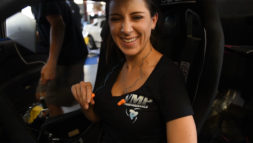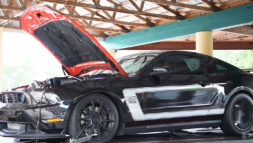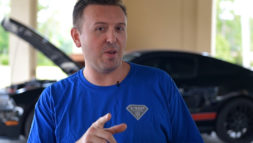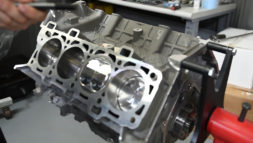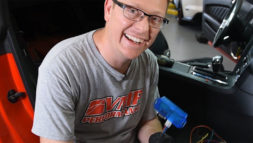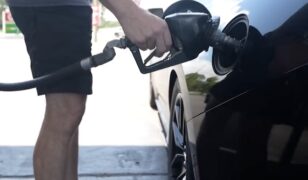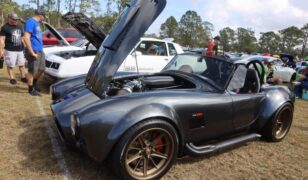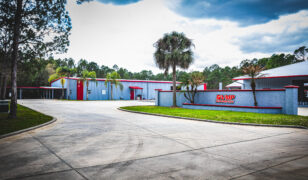TVS Supercharger Vs. Turbo power—two ways to reach 1,000 horsepower to the wheels with your Ford Mustang
By Evan J. Smith
The simple addition of a VMP supercharger can easily yield 600-plus rear wheel horsepower on an otherwise mildly modified Coyote. While 600 ponies can get you in the 10s, many enthusiasts want more. In fact, 700, 800, and even 900 rear wheel horsepower is not enough for the most extreme Mustang enthusiast seeking more power. The hardcore Stangbanger craves nothing short of 1,000 proud ponies.
To safely make four-digit power, it’s going to take a built short-block, upgraded fuel system, and a quality tune. Assembled right, however, your boost-fed 5.0 L can reach the top of the 1,000 horsepower mountain.
Naturally-aspirated engines use the downward stroke of the piston (on the intake stroke) to create a pressure drop in the cylinder. Pressure in the intake manifold is higher than the cylinder, so when the intake valve opens, air rushes in because pressure tries to equalize itself.
Forced induction, the process of feeding the engine airflow above what it could ingest naturally, can come by way of a supercharger, turbo, or a pair of turbochargers. These boost makers force air into the cylinders rather than letting the “natural” form of internal combustion occur.
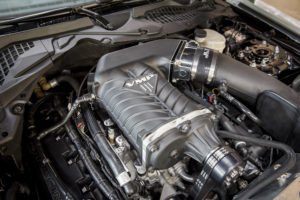 With forced induction, the pressure in the intake manifold is increased above what Mother Nature provides. So, with a compressor such as a supercharger or turbocharger, the pressure differential between the manifold and the cylinders is much greater. The result: when the intake valve opens, a larger volume of oxygen-containing air makes it into the cylinder. Having more oxygen present allows more fuel to be burned, and that’s where the increase in power comes from. Forced induction gives more than 100 percent volumetric efficiency and output can be doubled or tripled.
With forced induction, the pressure in the intake manifold is increased above what Mother Nature provides. So, with a compressor such as a supercharger or turbocharger, the pressure differential between the manifold and the cylinders is much greater. The result: when the intake valve opens, a larger volume of oxygen-containing air makes it into the cylinder. Having more oxygen present allows more fuel to be burned, and that’s where the increase in power comes from. Forced induction gives more than 100 percent volumetric efficiency and output can be doubled or tripled.
One thing you’ll have to manage with a forced induction setup is heat. Heat is a byproduct of compressing the air, so you’ll experience elevated intake air temperatures with both a supercharger and turbocharger. The increase in heat can be managed with an intercooler and heat exchanger, which is standard in most VMP Performance supercharger kits. A VMP intercooler and heat exchanger will provide consistent intake air temps and maximum performance whether on the street or track.
If 1,000 horsepower is your goal, VMP Performance can help. We offer a variety of power adder options, such as our new VMP Gen3 2.65 L TVS. We also install all forms of boosted applications, including turbocharger kits, at our state-of-the-art facility in New Smyrna Beach, Florida. As a complement to these products and services, we offer complete in-house and mail-order tuning to maximize performance, drivability, and reliability.
To help explain the advantages and disadvantages of superchargers and turbochargers, VMP Performance put together an educational and entertaining video that offers an illustrated explanation of how each work. The video takes a look at two 1,000-plus rear wheel horsepower Mustangs; one car with twin-turbos and the other with a VMP Gen3 TVS.
The video illustrates that while superchargers and turbos share a similar goal, they create boost differently. Superchargers are most often belt driven by the crankshaft. Turbos are driven by hot exhaust gasses. With a supercharger, especially a positive displacement (PD) supercharger, like the VMP Gen2R and Gen3, there is a direct relationship between engine speed and blower speed. It’s possible to manipulate supercharger speed by altering pulley sizes, but ultimately, maximum speed will be limited by engine speed and supercharger efficiency. In other words, simply turning the supercharger faster doesn’t always equal more power. What you’ll enjoy with a PD supercharger is instant torque in the low- and mid-range, with plenty of horsepower at the peak.
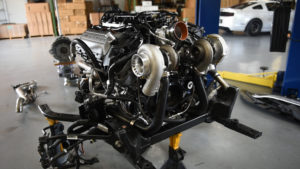 In contrast, because turbos are driven by exhaust gasses, you may have to wait for your boost. The reason is that turbo-produced boost can’t really be linked to engine speed. The engine first needs to produce suitable exhaust flow before turbos begin producing high levels of boost. This is one reason turbo sizing is paramount. If the turbo is too big, you’ll experience a lag at low rpm.
In contrast, because turbos are driven by exhaust gasses, you may have to wait for your boost. The reason is that turbo-produced boost can’t really be linked to engine speed. The engine first needs to produce suitable exhaust flow before turbos begin producing high levels of boost. This is one reason turbo sizing is paramount. If the turbo is too big, you’ll experience a lag at low rpm.
The benefit to turbocharging is efficiency. Driven by a byproduct of combustion, there is very little parasitic loss when compressing air and feeding the engine with a turbo. A supercharger, in comparison, uses engine power to create power.
In the video, the twin-turbo path to 1,000 horsepower starts with an L&M Engines sleeved block and forged internals. The convertible S550 Mustang also features a Hellion twin-turbo kit with the optional upgraded pair of 64/66 Precision turbos. It runs on E85 fuel. E85 has increased octane to prevent detonation and it also provides a greater cooling effect when compared to gasoline. This combo resulted in 1031 rear wheel horsepower and 878 lb·ft of torque.
The supercharged example is VMP’s own Track Attack, a 2017 Mustang GT. It sports a VMP Gen3 TVS supercharger atop the stock engine. VP C-16 race fuel is the fuel of choice for Track Attack. The GT rolled out 1020 rear wheel horsepower and 847 lb·ft of torque.
In comparing the two, you’ll see the supercharged boost gives a bigger kick down low. Track Attack produces over 800 lb·ft from 3,700 rpm to 6,300 rpm. The turbo Mustang also makes over 800, but only from 5,000 rpm to 6,300 rpm. Both options provide the means to achieve over 1000 rear wheel horsepower. As discussed, both routes have their own unique set of benefits, drawbacks, and unique characteristics. In the end, it is hard to be upset with 1000-plus rear wheel horsepower regardless of how one achieves it.
Tags:
BlowerfordFord Mustang GTFord Mustang GT ConvertibleHeat ExchangerhorsepowerhpIntercoolermustangpositive displacementSupercharged Mustang GTSuperchargerSupercharger kitTurboTurbochargedTVSTwin TurbovmpVMP Gen3 SuperchargerVMP Gen3 TVSVMP Heat Exchangervmp performanceVMP Superchargervmp tuningVMPPerformance

